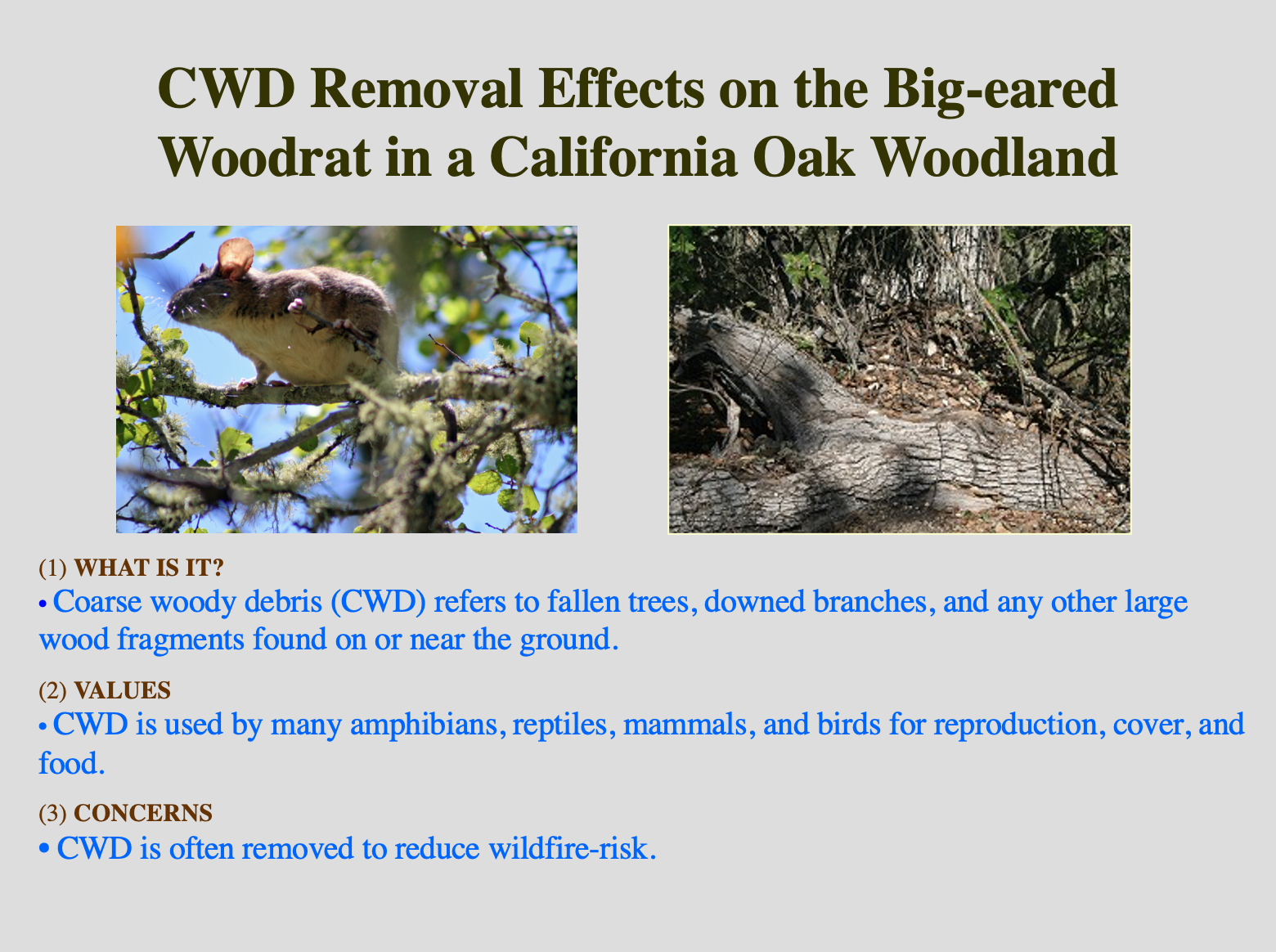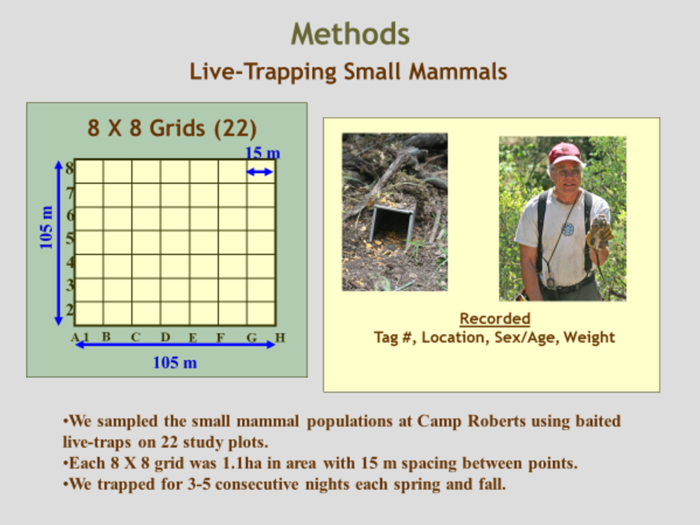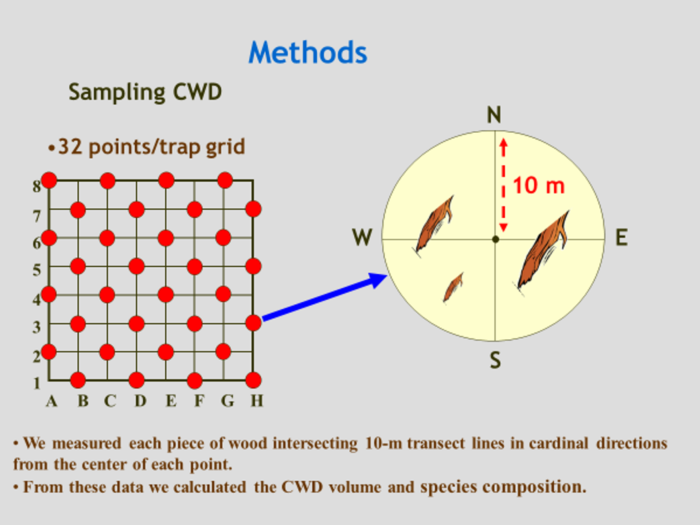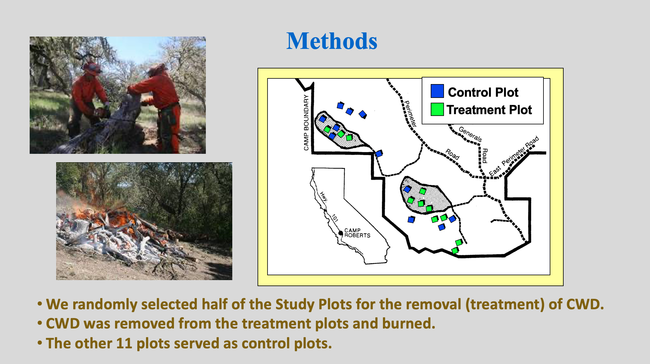Research
Research Description
The California Central Coast’s iconic natural environments provide the look and the natural diversity that contribute so importantly to it’s social, economic, and natural resource wellbeing. However, development pressures—and now,climate change—have continued to grow in scope and complexity. These changes can be damaging to the central coast’s native biodiversity and natural resources. Within this context, the aim of my research has been to generate and extend information that will make a positive impact on sustainable management.
In 1993 I began a long-term study on the ecology and habitat relationships of terrestrial vertebrates (mammals, birds, amphibians, reptiles) and to test the sustainability of management practices. Field sampling continued until 2014. This research project focused on small mammal demography and community dynamics, habitat use, and effects on demography of climate change. Some of this information is unknown for small mammals in California oak woodland and some of the relationships between environmental change and population persistence are so complicated that they need the discipline of a modeling approach, which a large data set can provide.
I have published science journal and layperson articles on bird and small mammal ecology and habitat preference, amphibian and reptile diversity and abundance in woodland at risk for sudden oak death disease, response of selected taxa to prescribed fire and experimental manipulation of downed dead wood, and the value to insectivorous bats of large oak trees in vineyards.
Where I had focused on field data collections, the past several years I have turned more toward writing and publishing of these data. Recently, I set up a collaboration with quantitative ecologists to assist with the analyses, interpretation, and publication of the longer-term data sets, especially on the response of small mammal populations to environmental change.
The Collaborators

Collaborator Study:
CWD Removal Effects on the Big-eared Woodrat in a California Oak Woodland

Methods
Woodrat Trapping

CWD Sampling

CWD Removal

Results
Two Key Findings:
(1) Coarse Woody Debris (CWD) is an important contributor to woodrat habitat quality, as it positively influenced both survival and reproduction.
(2) CWD promoted higher site fidelity, and therefore a safer environment, among resident woodrats.
Collectively, these findings have important population-level implications for big-eared woodrats, a keystone species on our study area. They may have particular significance given that California oak woodlands are currently faced with rapid and widespread environmental change.
Publications from the Camp Roberts Collaborative Study
Published:
Srivathsa, A., W. Tietje, V. Rolland, A. Polyakov, and M.K. Oli. 2019. Climatic drivers of pinyon mouse Peromyscus truei population dynamics in a resource-restricted environment. Population Ecology 61:122–131.
Tietje, W.D., A.Y. Polyakov, V. Rolland, J.E. Hines, and M.K. Oli. 2018. Climatic influences on demography of the California mouse (Peromyscus californicus) in semiarid oak woodland. Journal of Mammalogy 99:1149-1158.
Tietje, W.D., M.A. Hardy, and C.C. Yim. Coarse woody debris metrics in a California oak woodland. 2015. Pp. 61-72 In Proceedings of the Seventh California Oak Symposium: Managing Oak Woodlands in a Dynamic World, November 3-6, 2014, PSW GTR 251. Visalia, California.
Hardy, MA., J.K. Vreeland, and W.D. Tietje. 2013. Effects of repeated captures on body mall and survival of dusky-footed woodrats in a California oak woodland. The Southwestern Naturalist 58:305-313.
Hardy, M.A. J.K. Vreeland, and W.D. Tietje. 2013. Vegetation associations of birds wintering in a California oak woodland. Journal of Field Ornithology 84: 345-354.
Hardy, M.A., J.M. Zingo, and W.D. Tietje. 2013. Effects of repeated captures on body mass and survival of dusky-footed woodrats in a California oak woodland. The Southwestern Naturalist 58:305–313.
Lee, D.E. and W.D. Tietje. 2005. Dusky-footed woodrat demography and prescribed fire in a California oak woodland. Journal of Wildlife Management 69:1211-1220
In Preparation:
Chaudhary V., W.D. Tietje, A.Y. Polyakov, V. Rolland and M.K. Oli. In Review. Factors driving California pocket mice (Chaetodipus californicus) population dynamics.
Hardy, M.A. and W.D. Tietje. In preparation. Coarse woody debris removal effects on survival, reproduction, and site fidelity of the big-eared woodrat (Neotoma macrotis) in a California oak woodland.
Rolland, V., W.D. Tietje, A.Y. Polyakov, V. Chaudhary, and M.K. Oli. Submitted. Climatic factors and population demography in big-eared woodrat, Neotoma macrotis. Journal of Mammalogy.
Polyakov, A.Y., W.D. Tietje, A. Srivathsa, V. Rolland, J.E. Hines, and Madan K. Oli. Submitted. Multiple coping strategies maintain stability of a small mammal population in resource-restricted environments.
